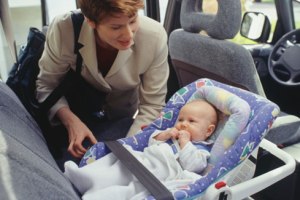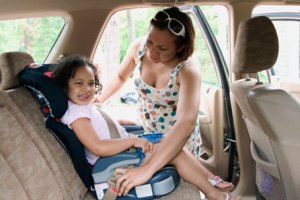Child Safety Week is Sept. 19 - 25, and it's no small cause: Car crashes are the leading cause of death for children 3 to 14 years old, and 2010 is on course to be a record-breaking year for the number of children who die from heat-stroke in parked cars.
"Children are the most precious cargo we can have," says José Alberto Uclés, a spokesman for the National Highway Traffic Safety Administration, or NHTSA. "We have to keep them safe."
An average of four children under the age of 14 are killed every day in motor vehicle crashes in the United States, Uclés says. But many injuries and fatalities are easily avoidable. Simple things like locking the power windows and using a booster seat can make cars much safer for children nationwide.
Safety First
We compiled our list of the best ways to keep your kids safe in the car with help from NHTSA, the traffic-safety arm of the Department of Transportation, based in Washington, D.C.
The No. 1 thing to remember when it comes to children and cars? Teach children well. Rollaway deaths, backover deaths and trunk entrapment can all be significantly mitigated by teaching them not to play in or around cars, and to move away from a vehicle when a driver gets in and when the car is started.
An important note: Although many cars come with detection devices like backup cameras or radars that emit sounds when they sense an obstruction behind the car, they cannot compensate for the act of circling the vehicle to make sure everything and every one is out of the way.
Installing Child Seats
Safety seats are another big component of safe driving with infants and toddlers. Using them in passenger cars reduces fatal injury by 71% for infants and by 54% for toddlers between the ages of 1 and 4. In pickup trucks, fatalities are reduced by 58% for infants and 59% for toddlers.
Vitally important is ensuring the seats are installed correctly--nearly 75% of them are not, according to NHTSA data. You can find a safety-seat inspector close to your neighborhood by clicking on the NHTSA website. Parents should know that children progress from rear facing, to front facing, to booster seat to seat belts--in that order, and according to manufacturer directions for height and body weight. And all children under the age of 13 should ride in the back seat.
The biggest factor here for parents is resisting the urge to "graduate" their kids prematurely, says Debbi Baer, a labor and delivery nurse in Baltimore who instructs new parents in how to attach a safety seat.
"We've got to get the public out of the feeling that a developing move is moving the kids to the next stage," Baer says. "Every time you move down a step [to a larger seat], you're actually decreasing the protection."
Even very small infants must be in a child seat, not a sling, soft infant carrier or harness. ("Nothing is safer than a rear-facing seat," Baer says. "The survival rates are absolutely astronomical.")
According to the American College of Obstetricians and Gynecologists, the safest place in the car for an infant is facing the rear in the middle of the back seat, with the front tilted at a 45-degree angle to help support the baby's large head and weak neck. (If the baby's head slips forward, place a rolled towel under the front edge of the baby carrier and using rolled towels on each side of the baby's head for extra support.)
Beat the Heat
A final precaution: Never leave children or babies unattended in a closed vehicle, even for a minute. The heating and cooling process for toddlers is vastly different than it is for adults, and that makes them particularly susceptible to overheating in a locked car or trunk.
According to NHTSA, even cool outside temperatures in the 60s can cause the car's interior to hit 110 degrees Fahrenheit and higher. (The inside temperature can rise almost 20 degrees within the first 10 minutes.) What's more, children's bodies overheat easily--infants and children under four are among those at greatest risk for heat-related illness--and children are less able to lower their body heat by sweating. That means that inside a hot car, a toddler's body temperature can rise three to five times as quickly as that of an adult, which can lead directly to heatstroke and death.
It's a sobering truth, this year especially: To date there have been 41 children who died from vehicular hyperthermia in 2010--already many more than last year's total of 33.
Five Ways To Keep Your Kids Safe In The Car
1. Babies face backward.
Face babies backward in their car seats. And keep them that way for as long as possible up to the height or weight limit of the particular seat. At a minimum, keep infants rear-facing until the age of 1 and until they weigh at least 20 pounds.
2. Toddlers face forward.
Keep toddlers in forward-facing car seats until they reach the upper weight or height limit of the particular car-seat (usually around age 4 and 40 pounds).
3. Use a booster seat.
Keep young children in booster seats--in the back seat--until they are as old as 8 years or at least 4'9'' tall. One way to tell if they're positioned correctly in the booster is to look at the seat belt: It should fit with the lap belt laying across the upper thighs and the shoulder belt fitting easily across the chest.
4. Never leave children inside a parked car.
According to NHTSA, even cool outside temperatures in the 60s can cause the car's interior to hit 110 degrees Fahrenheit and higher. (The inside temperature can rise almost 20 degrees within the first 10 minutes.) If a child is inside the vehicle, they can quickly succumb to heatstroke and death.
5. Protect your pregnancy.
When pregnant, wear the seat belt low across the belly, with the center portion placed firmly along the breastbone. Contrary to some myths, it's always safer to wear a seat-belt, even when eight or nine months pregnant, than to not wear one for fear of crushing the unborn child in the event of a crash.
Click here to see the full list of Ways To Keep Your Kids Safe In The Car


















